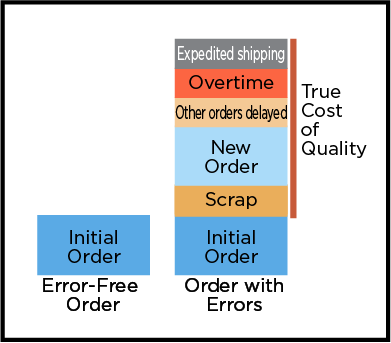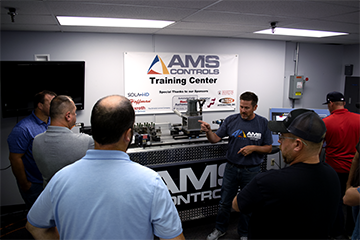When the subject of how to improve product quality comes up in a management meeting, it won’t be surprising if one of the suggestions offered includes adding a final inspection before shipping to make sure all orders sent out are accurate. Sounds reasonable enough. A final inspection sounds like an effective way to double check orders before shipping. How good is a final inspection in maintaining quality? Let’s examine how final inspection works and how it impacts the cost to maintain quality:
Calculating the True Cost of Quality
 A large order arrives at final inspection for one of your key customers. Final inspection finds the order riddled with errors: the parts have the wrong gauge and color, and the lengths are off by one to two inches. You may think, “Success! Final inspection worked and saved us from sending out a wrong order.” While you have definitely saved yourself the embarrassment of sending a flawed order to your valuable customer, what happened at final inspection is far from a success.
A large order arrives at final inspection for one of your key customers. Final inspection finds the order riddled with errors: the parts have the wrong gauge and color, and the lengths are off by one to two inches. You may think, “Success! Final inspection worked and saved us from sending out a wrong order.” While you have definitely saved yourself the embarrassment of sending a flawed order to your valuable customer, what happened at final inspection is far from a success.
First, you have the initial cost of producing the incorrect order, along with the fact that all that material is now scrap. Then there is the added cost of a new RUSH order, not to mention the reality that this unforeseen rush order will cause other orders to be delayed. Oh wait, after all that, the job still has to go through final inspection yet again. Then there is the fact that you’ve probably taken more time than was expected, and you’ll have to expedite delivery, adding more cost.
In other words, the true cost of quality goes beyond the cost of employing final inspectors. The true cost of quality is more accurately defined as all costs that would not have been incurred if the quality were perfect.
A Different Way to Look At Quality
The true cost of quality is more accurately defined as all costs that would not have been incurred if the quality were perfect.
There are many that believe final inspection actually does little to contribute to quality. Proponents of this argument say that when companies rely on final inspections to maintain quality control, it’s easy to slip into the habit of allowing poor quality or even manufacturing errors to occur, bolstered in the belief that final inspection will catch all the errors and maintain quality standards.
W. Edwards Deming, credited for helping introduce concepts of quality in manufacturing to post-war Japan, had this to say about quality: “Inspection does not improve the quality, nor guarantee quality. Inspection is too late. The quality, good or bad, is already in the product. Quality cannot be inspected into a product or service; It must be built into it.”
What Does it Mean to Have Quality Built In?
For something to be built in, it essentially becomes part of the other component. For example, built-in book shelves are part of the wall, and it is impossible to separate one from the other. In short, to design a built-in quality product, quality needs to be an integral component from the very start.
For roll formers, built-in quality can take the form of a roll forming process that is engineered to halt manufacturing when errors such as wrong material, gauge or color are detected. Engineered to allow production to proceed only when errors of this nature are corrected, built-in quality engineering helps to eliminate expensive scrap costs. Built-in quality can also appear as well-engineered controllers to accurately calculate length and punch patterns. The exercise of appropriately maintaining all components of a roll forming line in peak working condition is also a manifestation of built-in quality.
For trim shop owners with folding machines, built-in quality can include ensuring the profile can be manufactured on their specific folding machine at the design stage before the profile goes into production. Step-by-step auto sequencing for every profile is another way to ensure that profiles are made the same way every time, by every operator.
The common thread in both scenarios is a process that is designed to make it possible to always manufacture an error-free product. Standardized work processes and procedures also ensure every person involved knows exactly what is expected and has the tools and knowledge to always produce a quality product.
How to Build Quality Into Your Process?
As one of the principles of lean manufacturing, built-in quality is a process. The process towards built-in quality moves an organization through several phases, from simply detecting errors, to ultimately eliminating errors from ever being produced. As your organization moves from one phase to another in the built-in quality process, the quality of your process will naturally improve, and you will begin to see a decrease in your cost of quality. Quality management expert Phil Crosby said, “Quality is free… It is always cheaper to do the job right the first time.”
Another interesting result of improved built-in quality is the reduced need for inspection. While this sounds counter-intuitive, it’s actually true. Think about it. With a process that has quality built in, defects will be caught and corrected long before final inspection.
If you’re ready to begin your built-in quality journey, here are some pointers to get started on the path of built-in quality.
Make quality everyone’s job
- Clear and concise communication helps everyone in your organization understand their role in maintaining quality, and what they can do to make a difference. Communication can also help employees feel important and valued.
- Use cross-functional teams to foster collaboration and build a shared vision.
Standardize work processes
- Standardized operating procedures and policies send a clear message and set expectations for employees.
- As part of a standardized process, standardized tools and equipment removes process variation and helps improve operator efficiency.
Start with inspections, but think beyond inspections
- While inspections may be a necessary place to start, inspections are only a first step on your journey to built-in quality. Remember, inspections can be costly and unreliable; inspections don’t really improve quality, they just find a lack of quality.
- There is more to quality than just finding the mistakes or errors. Quality should eliminate mistakes or errors altogether.

AMS Controls believes strongly in training and provides quarterly training opportunities.
Continuous improvement is a must
- Don’t get overwhelmed by all the areas that need improvement. Take on improvement projects carefully by weighing the importance and impact, and also the feasibility based on budget and resources. Make a plan, execute, and then measure your improvements. Take the time to make adjustments as needed until you achieve your desired results.
Train and educate
- Provide an environment that encourages employees to learn from each other. This helps to build up a foundation of knowledge among a team of employees instead of one employee being the resident expert.
Leaders are visible, leaders are teachers
- Leaders should provide support and resources to help employees excel. Leaders should focus on more than just meeting goals and quotas. Work on coaching and helping employees grow.
Eliminate fear
- Remove fear and use open and honest communication. When errors occur, don’t play the blame game. The goal is to achieve quality by doing more things right.
Encourage teamwork and personal pride
- Treat workers the same. Don’t make them compete with each other for monetary or other rewards.
- Allow everyone to take pride in their work without being rated or compared.
Built-in Quality is a Process of Continuous Improvement
Built-in quality is a journey of continuous improvement. The key to successfully forming a built-in quality culture is communication, support and teamwork. As you walk through the process of implementing built-in quality, you will begin to experience the many positive results: an actively engaged team, improved efficiencies and reduced costs, and most importantly, increased profitability and happy customers.
About AMS Controls
AMS Controls has a complete production management system to optimize the manufacturing of panels, purlins, trim, studs, and more. Since 1977, AMS Controls has sold 13,000+ controllers worldwide.
Industry leaders have chosen AMS Controls’ complete production management system to optimize the manufacturing of roll forming cut-to-length panels, purlins, trim, studs and structural products. Our solutions can be used with any brand of roll former or folder to effortlessly eliminate mistakes, manage coil inventory and track production.